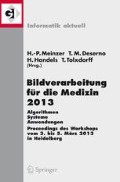Zusammenfassung
Segmentation of patient data often is a mandatory step for surgical simulations featuring haptic rendering. To alleviate the burden of manual segmentation we chose direct haptic volume rendering based on CT gray values and partially segmented patient data. In this study, the fields of application are lumbar puncture and spinal anesthesia. We focus on a new evaluation method driven by ray-casting to define paths from the skin to the spinal canal. In a comparison of our reference system AcusVR to a newer algorithm, force outputs are found to be similar in 99 % of the tested paths.
Access this chapter
Tax calculation will be finalised at checkout
Purchases are for personal use only
Preview
Unable to display preview. Download preview PDF.
Literatur
Abolhassani N, Patel R, Moallem M. Needle insertion into soft tissue: a survey. Med Eng Phys. 2007;29(4):413–31.
Ullrich S, Kuhlen T. Haptic palpation for medical simulation in virtual environments. IEEE Trans Vis Comput Graph. 2012;18(4):617–25.
Ullrich S, Grottke O, Fried E, et al. An intersubject variable regional anesthesia simulator with a virtual patient architecture. Int J CARS. 2009;4(6):561–70.
Färber M, Hoeborn E, Dalek D, et al. Training and evaluation of lumbar punctures in a VR-environment using a 6DOF haptic device. Stud Health Technol Inform. 2008;132:112–4.
Färber M, Hummel F, Gerloff C, et al. Virtual reality simulator for the training of lumbar punctures. Methods Inf Med. 2009;48(5):493–501.
Mastmeyer A, Fortmeier D, Handels H. Direct haptic volume rendering in lumbar puncture simulation. IOS Press; 2012.
Lundin K, Ynnerman A, Gudmundsson B. Proxy-based haptic feedback from volumetric density data. Eurohaptics Conference. 2002; p. 104–9.
Bresenham JE. Algorithm for computer control of a digital plotter. IBM Syst J. 1965;4(1):25–30.
Author information
Authors and Affiliations
Corresponding author
Editor information
Editors and Affiliations
Rights and permissions
Copyright information
© 2013 Springer-Verlag Berlin Heidelberg
About this paper
Cite this paper
Mastmeyer, A., Hecht, T., Fortmeier, D., Handels, H. (2013). Ray-Casting-Based Evaluation Framework for Needle Insertion Force Feedback Algorithms. In: Meinzer, HP., Deserno, T., Handels, H., Tolxdorff, T. (eds) Bildverarbeitung für die Medizin 2013. Informatik aktuell. Springer, Berlin, Heidelberg. https://doi.org/10.1007/978-3-642-36480-8_3
Download citation
DOI: https://doi.org/10.1007/978-3-642-36480-8_3
Published:
Publisher Name: Springer, Berlin, Heidelberg
Print ISBN: 978-3-642-36479-2
Online ISBN: 978-3-642-36480-8
eBook Packages: Computer Science and Engineering (German Language)

